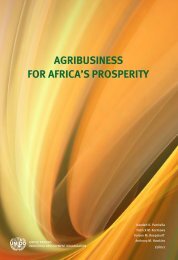Collection of Case Studies 2. - Seas of Change Initiative
Collection of Case Studies 2. - Seas of Change Initiative
Collection of Case Studies 2. - Seas of Change Initiative
You also want an ePaper? Increase the reach of your titles
YUMPU automatically turns print PDFs into web optimized ePapers that Google loves.
First findings <strong>of</strong> research <strong>of</strong> the International Institute <strong>of</strong> Tropical Agriculture in Uganda are very encouraging.Results show that intercropping c<strong>of</strong>fee and banana appears to be more pr<strong>of</strong>itable than c<strong>of</strong>fee mono-cropping.Since smallholders in sub-Saharan Africa are <strong>of</strong>ten resource-constrained the intercropping systems like c<strong>of</strong>feebananamay provide an opportunity to optimize resource-sue efficiency, allow farmers to spread risks, and strikea balance between food and cash generation. 22<strong>Case</strong> set-upThe plantain chain <strong>of</strong> c<strong>of</strong>fee farmers supported by VECO is situated in the province <strong>of</strong> Zamora Chinchipe, locatedin the Amazon region.Chain related dataPlantain production: 2,962 to 3,360 tons <strong>of</strong> plantains per year, <strong>of</strong> which 1,163 tons by APEOSAE, APECAP andACRIM. To produce 1 ton <strong>of</strong> chips, 4 tons <strong>of</strong> plantains are required.Plantain demand: 2,240 tons <strong>of</strong> plantains per year, <strong>of</strong> which Ethiquable demands 5%, local mar-kets some23%, regional markets 38%, domestic consumption 4% and animal consumption 6%. There is no demand forthe remaining 24% at this moment in time.Production cost: USD 0.13 per kilogram (national average USD 0.10 per kilogram).(López and Choez, 2009)Average farm size:28% <strong>of</strong> banana producers have up to 1 ha <strong>of</strong> crops, 18% <strong>of</strong> producers have between 1 to 3hectares <strong>of</strong> banana crops (Flores, 2011).3. Problem analysisMain problems/bottlenecks faced by c<strong>of</strong>fee farmers in the plantain chainA problem arose when family farmers discovered that their production capacity (c<strong>of</strong>fee) was insufficient tosupport their families, particularly in times <strong>of</strong> crises, be it because <strong>of</strong> bad climatologic conditions or low marketprices. Hence, FAPECAFES looked for chain improvements with the help <strong>of</strong> Ethiquable, a French importer <strong>of</strong> fairtrade products. Together they looked into the c<strong>of</strong>fee cultivation process and they explored the option <strong>of</strong>commercialising plantains, which were growing in between the c<strong>of</strong>fee plants.A general problem that FAPECAFES faces at the moment is the uncertainty in demand for plantains and chips. Ifproduction and storage capacity would increase as planned, the supply for which there is no demand would riseeven further. FAPECAFES is working on these capacities, it has made projections for the coming years on theselling possibilities, and is executing a feasibility study for building a chip processing plant <strong>of</strong> their own.Another impediment to the sector’s growth is the high cost <strong>of</strong> processing plantains into chips and the completeabsence <strong>of</strong> organically produced chips. Although the chips produced from Zamora Chinchipe’s plantains alreadybear the fair trade label, the origin <strong>of</strong> the chips is insufficiently traceable to give it any organic label. The problemat the processing level is the difficulty in obtaining the appropriate oil (which is organically certified).A third element to afflict the plantain’s sector is the absence <strong>of</strong> a government sanctioned framework to streamlineproduction processes and market chains. Efforts have stalled to implement an initiative that would stimulate andcontrol production and marketing processes <strong>of</strong> the plantain and feed policies to increase the plantain’scompetitiveness on the market.A fourth impediment for the plantain farmers (and others) is the bad condition <strong>of</strong> regional and local roads in theregion, complicating the movement <strong>of</strong> goods, especially under bad weather conditions. <strong>Collection</strong> and storagefacilities in the region are insufficient, causing delays in the primary processing, under-optimal use <strong>of</strong> labour andloss <strong>of</strong> produce. A last important hindrance concerning infrastructure is the absence <strong>of</strong> a factory that couldprocess plantain into organic chips, charging lower processing costs.4. Evolution <strong>of</strong> the initiativeFarmer organisation and its pathway towards sustainabilityUnderlying motives <strong>of</strong> FAPECAFES for investing in plantain chipsThe c<strong>of</strong>fee farmers <strong>of</strong> Zamora Chinchipe have traditionally, since colonial times, been growing plantains, but forthe sole purpose <strong>of</strong> providing shadow to the c<strong>of</strong>fee plants and for auto-consumption. The plantains from the22Similar findings have been found in studies conducted in Nigeria, Ghana, Nicaragua and East Africa.57







